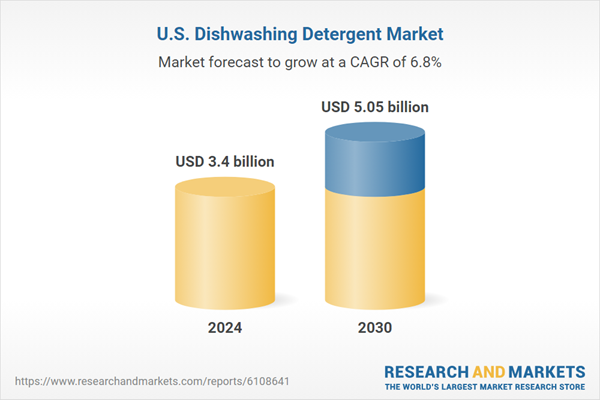Speak directly to the analyst to clarify any post sales queries you may have.
10% Free customizationThis report comes with 10% free customization, enabling you to add data that meets your specific business needs.
Key Market Drivers
Rising Adoption of Automatic Dishwashers
The growing use of automatic dishwashers in U.S. households is a key factor driving the dishwashing detergent market. As busy lifestyles and dual-income households become more common, consumers increasingly opt for time-saving appliances. Millennials and Gen Z consumers, in particular, are embracing smart home solutions, contributing to rising dishwasher ownership. This shift fuels demand for machine-specific detergents, including tablets, powders, and gel formulations tailored for these appliances. Manufacturers are responding with advanced, low-residue, and high-performance formulas that are compatible with water- and energy-efficient dishwashers. With rising homeownership and modern kitchen upgrades, the transition from handwashing to machine washing is expected to further strengthen demand for automatic dishwashing detergents.Key Market Challenges
Intense Price Competition and Private Label Threats
Price competition remains a major hurdle in the U.S. dishwashing detergent market, especially due to the growing influence of private label brands from major retailers like Walmart, Costco, and Target. These store-brand detergents offer similar quality at lower price points, attracting budget-conscious consumers. This trend places considerable pressure on national brands to maintain competitiveness while protecting margins. Although premium features - such as eco-friendliness or targeted cleaning - may justify higher pricing, many consumers still prioritize affordability. As a result, leading brands often resort to heavy promotional campaigns and discounts, which can erode brand equity and hinder long-term loyalty. Navigating this cost-conscious landscape while maintaining product differentiation poses a continual challenge for established players.Key Market Trends
Rise of Multi-Functional and Specialized Detergent Formulations
The U.S. dishwashing detergent market is experiencing a notable shift toward multi-functional and specialty formulations that offer more than just basic cleaning. Consumers increasingly expect detergents to deliver benefits such as odor removal, antibacterial action, grease-cutting, spot prevention, and quick drying. In response, brands are developing premium machine detergents with integrated rinse aids, glass protection, and solutions suited for hard water conditions. Similarly, handwashing liquids are being enhanced with skin-friendly ingredients like aloe vera and vitamin E, targeting users with sensitive skin. These innovations reflect consumer demand for convenience, efficiency, and added value, prompting continuous development of advanced, hybrid detergent products.Key Market Players
- The Procter & Gamble Company
- Reckitt Benckiser Group plc
- Colgate-Palmolive Company
- Henkel AG & Co. KGaA
- Unilever PLC
- Miele & Cie. KG
- Dropps (Cot'n Wash, Inc.)
- Blueland, Inc.
- Ecolab Inc.
- S.C. Johnson & Son, Inc.
Report Scope:
In this report, the United States Dishwashing Detergent Market has been segmented into the following categories, in addition to the industry trends which have also been detailed below:United States Dishwashing Detergent Market, By Product:
- Machine Dishwashing Detergents
- Hand Dishwashing Detergents
- Others
United States Dishwashing Detergent Market, By Distribution Channel:
- Offline
- Online
United States Dishwashing Detergent Market, By Region:
- South
- Midwest
- West
- Northeast
Competitive Landscape
Company Profiles: Detailed analysis of the major companies present in the United States Dishwashing Detergent Market.Available Customizations:
With the given market data, the publisher offers customizations according to a company's specific needs. The following customization options are available for the report.Company Information
- Detailed analysis and profiling of additional market players (up to five).
This product will be delivered within 1-3 business days.
Table of Contents
Companies Mentioned
- The Procter & Gamble Company
- Reckitt Benckiser Group plc
- Colgate-Palmolive Company
- Henkel AG & Co. KGaA
- Unilever PLC
- Miele & Cie. KG
- Dropps (Cot'n Wash, Inc.)
- Blueland, Inc.
- Ecolab Inc.
- S.C. Johnson & Son, Inc.
Table Information
| Report Attribute | Details |
|---|---|
| No. of Pages | 87 |
| Published | July 2025 |
| Forecast Period | 2024 - 2030 |
| Estimated Market Value ( USD | $ 3.4 billion |
| Forecasted Market Value ( USD | $ 5.05 Billion |
| Compound Annual Growth Rate | 6.8% |
| Regions Covered | United States |
| No. of Companies Mentioned | 10 |









